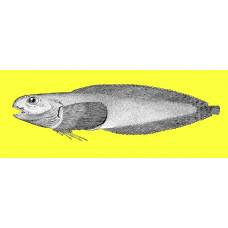Latin name
Liparis gibbus
Other name
Polka-dot snailfish, dusky snailfish, iparis cyclostigma, liparis liparis, liparis rufescens.
Identification
The Variegated Snailfish has a compressed body that is relatively tall, with a height greater than 0.5 times its length excluding the head. The head is 3.5 times as long as the body. The mouth slit is weakly curved. The cheeks slope at about a 45° angle. The relatively large eyes have somewhat protruding upper margins of the orbits above a flat interorbital space. The teeth are broad. The gill opening is large and extends to the base of the 14th to 15th pectoral fin rays. The sucker's longitudinal diameter is greater than the snout's length and only slightly greater than the distance from the sucker to the anus. The skin on the sides of the body is bare. However, there are a few small spines embedded in the skin on the head and the anterior part of the body.
Features of fish fins
In these fish, the dorsal fin begins somewhat behind the gill opening. Its first rays are noticeably short, and the length of the posterior third of the rays does not exceed the length of the snout. The dorsal fin fuses with the caudal fin at 0.5 of the caudal fin's length at the posterior end, while the anal fin fuses with the caudal fin at about two-thirds of the caudal fin's length. The upper lobe of the pectoral fin extends vertically to the beginning of the anal fin; the rays of the lower lobe do not extend to the anal opening, falling short by about the diameter of the eye. The notch of the pectoral fin is deep and equal to one-third the length of the longest lower lobe ray.
Fish colouring
The variegated snailfish is uniformly gray. Its fins are slightly darker with a light rim along the edge of the pectoral fin, which is formed by the light tips of its rays. There is no definite patterning on the head. Its jaws and chin are gray. The lips, breast, and belly are white.
Distribution
This fish inhabits the Arctic waters of the Bering and Chukchi Seas. Close forms of this fish are found in the Sea of Okhotsk, the Sea of Japan, and off the Pacific coast of North America.
Habitat
The variegated snailfish inhabits the near-bottom zone of the Arctic Ocean at depths ranging from 0 to 647.9 meters (2,126 feet). It is also found in the Pacific Northwest, the Northeast Atlantic Ocean, Greenland, Canada, the Baffin Islands, and southeast Alaska, where it lives among algae and rocks.
Size
This species of fish can grow to a total length of 52 centimeters (20 inches).
Behavior
These fish were found to exhibit biofluorescence as juveniles, emitting green and red fluorescence from different parts of their bodies.
Food and feeding habits
Variegated snailfish primarily feed on crustaceans, including both benthic and pelagic species. Amphipods of the family Hyperiidae are the most common prey, though crabs have also been noted.
Reproduction
This species likely spawns throughout the summer at the mouth of the St. Lawrence River. Larvae were collected there from June through September, and the smallest specimens were collected in September.
Fishing
This species is not commercially important.
Relationship with a person
This is a type of fish that is harmless to humans.
| Classification | |
| Phylum | Chordata |
| Class | Actinopterygii |
| Squad | Perciformes |
| Family | Liparidae |
| Genus | Liparis |
| Species | L. gibbus |
| Features | |
| Conservation status | Not Evaluated |
| Habitat | Bottom |
| Life span, years | No information |
| Maximum body weight, kg | No information |
| Maximum length, cm | 52 |
| Sailing speed, m/s | No information |
| Threat to people | Not edible |
| Way of eating | Bentophage |
Variegated snailfish
Tags: variegated snailfish

